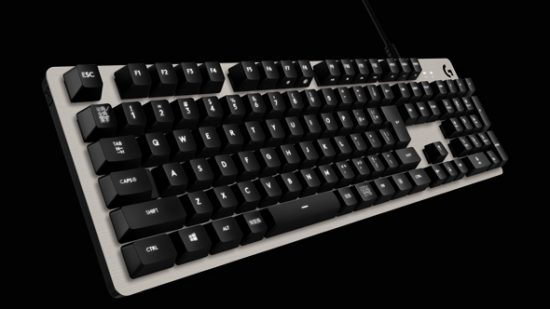Logitech Spotlight posts are created in partnership with Logitech.
Keyboards are simple: 100-something plastic keys in a case, and a pile of magic rubber springs that talk to your computer. You’ve already got one. It works. Why spend money on anything more?
Because simple keyboards are pretty hopeless for gaming, that’s why—and that’s before you even get to the magic rubber springs. Standard keyboards work just well enough that you can never quite be sure if it was your clumsy fingers that messed up. Until you try a properly built keyboard, at least, and realize it was neither.
Here’s what it takes to construct a device that really does justice to your gaming.
A strong, light chassis
Nothing makes greater physical demands on your keyboard than gaming—immersion easily leads to heavy-handed panicked responses and bouts of furious anger (that’s not just us… right?). So you need a strong chassis. The new G413 Carbon and Silver Mechanical Backlit Gaming Keyboard from Logitech G, for instance, uses 5052 aluminum as a sturdy, reliable design.
Though aluminum is an element (atomic number 13, FYI), what you buy is not all the same stuff. That’s because most ‘aluminum’ is actually one alloy or another, and different alloys have different strengths. The G413’s is alloyed with magnesium and chromium, because it’s hardwearing, corrosion resistant, anti-static and non-slip. It’s called 5052—it’s actually the stuff they make pressure vessels and aircraft from. It’s very strong, fatigue-resistant, and very light.
Mechanical switches
If you want feedback you can really feel, you need physical switches. Rubber dome switches, with their undetectable electronic pulses, just don’t cut it (they’re also slower-reacting, with an actuation time almost double the Romer-G’s 5 milliseconds).
Tuned to actuate after 1.5mm with a pressure of just 45g, these steel-sprung switches fire almost instantaneously with a deep click. The dual-contact sound is damped to avoid noise pollution—no cheap, tinny clattering here—while the keycaps are heavily scooped for easy finger placement and clear feedback.
The result is solid yet light action that’s measurably easier on your hands. The switches are also durable to 70 million key presses, whereas standard boards are around five million.
Both editions of the G413 come with 12 additional gaming keycaps and a puller, should you want to further differentiate the keys.

Class-leading lighting
Using a black keyboard in a dark room would be plain silly without quality backlighting. Both the Carbon and Silver editions of the G413 benefit from surface-mounted LEDs, which are brighter, more even and more reliable than the switch-mounted lamps on regular mechanical keyboards. The Silver option has white lighting, while the moody Carbon gets a devilish crimson.
A dedicated game mode makes life easier still, by numbing superfluous and potentially game-killing keys like the Windows button.
Hardcore cabling
All this precision and engineered strength would be for nothing if the connecting cable was flimsy enough to let the cable kink, breaking the fragile wires inside. Constantly wrapping the flex around the keyboard or shoving everything in bags ruins unarmored cables rapidly. Logitech G uses a braided cable—vital in an eSports-friendly keyboard that will likely be moved often—and a protective boot at the cable exit.
A secure stance
No gamer wants to feel their keyboard sliding away from them at a critical moment, or listen to it buzzing and rattling against tabletops. Heavy rubber feet are a must—forget about cases with molded plastic bumps for proper gaming use.
But don’t assume that even this is all it takes. For more details on the G413 Carbon and Silver Mechanical Backlit Gaming Keyboard and other Logitech products, visit the official page.
